Страница 2 из 21
Добавлено: 21 дек 2006, 15:28
Andrej
В конечном виде старый Зенит с новой кирлиан-душой выглядит следующим образом:
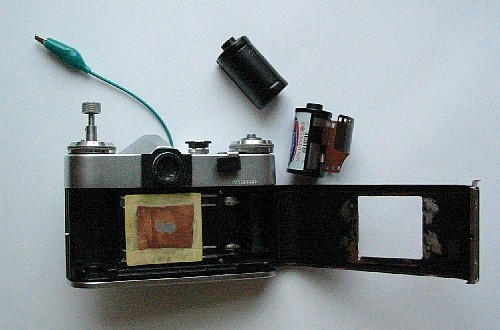
Нужно не забыть перемотать плёнку на кассету в обратном направлении, таким образом, чтобы при вставке кассеты с плёнкой рабочая поверхность плёнки (с эмульсией, у цв. плёнок она корично–оранжевая, светлее, чем обратная, не рабочая сторона, а у ч\б плёнок – светло-серая, тоже светлее, чем обратная, не рабочая сторона).
После вставки плёнки и закрытия крышки, подключение его к катушке, кирлиан–фотоаппарат готов к работе. Все ч\б и цв. плёнки являются сегодня панхроматическими, т.е. реагируют в равной степени на весь спектр световых волн. Поэтому работать надо в почти полной темноте. В полной темноте работать невозможно, т.к. невозможно правильно заземлить и позиционировать объект на рабочей площади. Для этого необходимо сумерки, чтобы глаз, привыкший к темноте, мог с трудом, но надёжно ориентироваться на рабочем электроде. Можно сделать крышку, закрывающую вырезанное окошко фотоаппарата на то время, когда идёт подготовка объекта, и открывать эту крышку только для непосредственного позиционирования объекта.
После того как сделанны кирлиан–снимки, плёнку ножно смотать обратно на кассету, и можно её проявлять. Ч\б плёнку можно проявить самому, а затем самому и напечатать фотографии. А цв. плёнку можно отдать для проявления и печати фотографий в любое фотоателье или фотомагазин.
Добавлено: 21 дек 2006, 15:29
Andrej
Несколько примеров ч\б фотографий сделанных на ч\б плёнку (фн 64, Тасма).
Все фотографии даются в оригинальном цвете, без обработки Photoshop'ом.
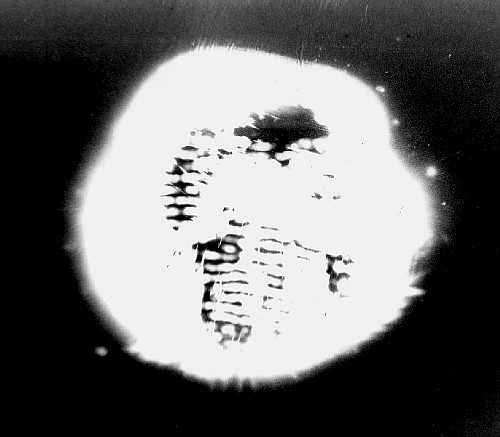
Палец средний, правой руки.
Добавлено: 21 дек 2006, 15:30
Andrej
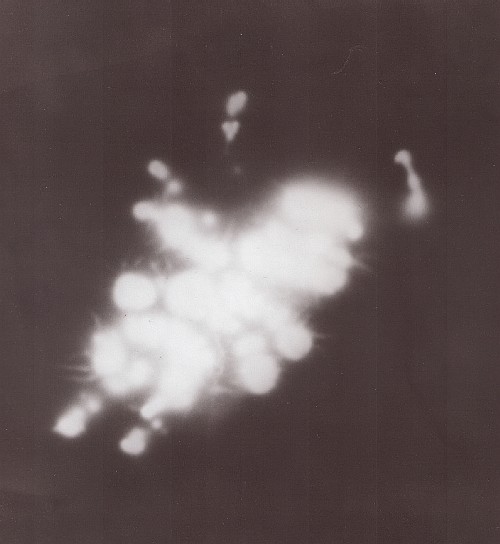
Пчела.
Добавлено: 21 дек 2006, 15:31
Andrej
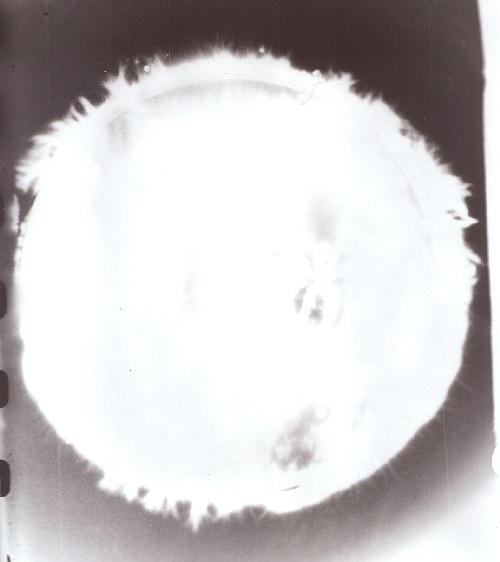
Монета (слева видны окошечки перфоратора плёнки).
Добавлено: 21 дек 2006, 15:31
Andrej
Теперь несколько примеров цв. фотографий, сделанных на цв. плёнку (200 ISO, Rosmann)

Медная монета 1 цент.
Добавлено: 21 дек 2006, 15:32
Andrej
Она же в "живую":
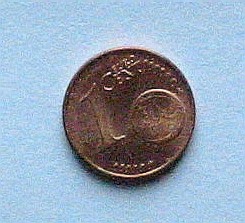
Добавлено: 21 дек 2006, 15:32
Andrej

Листочек растения (чёрное пятно посредине – место прижатия листочка металлическим "крокодилом", синие точки по периметру – место касания концов листочка).
Добавлено: 21 дек 2006, 15:32
Andrej

Фигурная металлическая шайба. Зелёный фон фотографии говорит о том, что плёнка засвечена фоновым сумрачным освещением во время подготовки объекта.
Добавлено: 21 дек 2006, 15:33
Andrej
Она же в "живую".
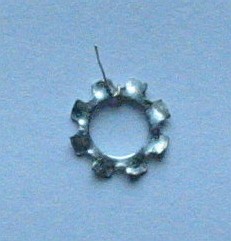
Добавлено: 21 дек 2006, 15:33
Andrej
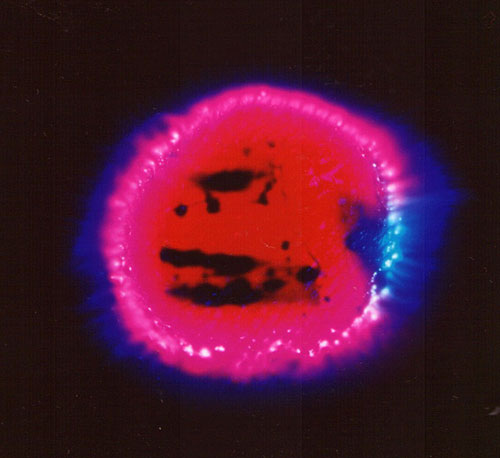
Палец.
Добавлено: 21 дек 2006, 15:33
Andrej

Палец с точкой непонятного происхождения, которая при съёмке не замечалась.
Добавлено: 21 дек 2006, 15:33
Andrej
Тот же снимок, фрагмент с точкой.

Добавлено: 21 дек 2006, 15:34
Andrej

Гвоздь маленький.
Добавлено: 21 дек 2006, 15:34
Andrej
Он же в "живую".
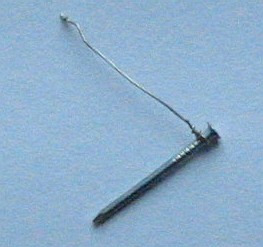
Добавлено: 21 дек 2006, 15:34
Andrej

Шурупчик.
Добавлено: 21 дек 2006, 15:35
Andrej
Он же в "живую".
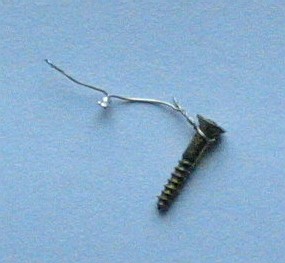
Добавлено: 21 дек 2006, 15:35
Andrej
Если есть вопросы, то спрашивайте

Добавлено: 06 янв 2007, 23:04
Andrej
Теперь короткая история кирлиан-движения и несколько кирлиан-снимков из книги американского исследователя кирлиан-эффекта John Iovine "Kirlian Photography. A Hands-On Guide", TAB Books, 1994.
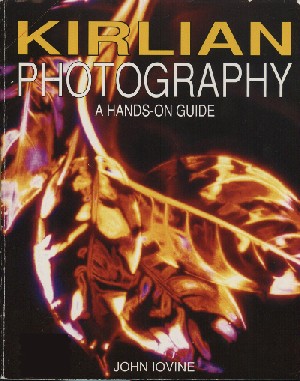
John Iovine писал(а): Kirlian photography: a short history
The beginnings of electro-photography can be traced back to the late 1700s. At this time, Georg Christoph Lichtenberg appears to have been the first to observe electro-photographs. Lichtenberg made note of his observations of pictures made in dust created by static electricity and electric sparks.
Nicola Tesla (1880) photographed many corona discharges using his famous Tesla coil. In the early 1900s, Russian engineer and electrical researcher Yakov Narkevich-Todka exhibited interesting electro-photographs he made. A little later (but around the same time) Dr. F.F. Strong of Tufts University Medical School used a Tesla coil to make electro-photographs of his hand.
Russian researchers Semyon Davidovich Kirlian and his wife Valentina began their work with high-voltage photography by accident in 1939. Semyon Kirlian was an electrical repairman in the city of Krasnodar. He had been called to do a repair at a local research institute. While at the institute, he happened to see a demonstration of a high-frequency device used for electrotherapy. As a patient underwent treatment, Kirlian noticed small flashes of light between the patient's skin and the machine's glass electrodes. Kirlian wondered if he could photograph that light. Kirlian substituted a metal electrode for the glass one used in the machine to prevent exposing the film. Then, using himself as a subject, he was able to photograph the corona discharge.
Kirlian collaborated with his wife for over 30 years of developing equipment and studying electro-photography. They made instruments to examine high-frequency currents on living tissues as well as on inanimate materials.
The Kirlians' work was first made known to the general public in this country by a book published in 1970 titled "Psychic Discoveries Behind the Iron Curtain" by Sheila Ostrander and Lynn Schroeder. The Kirlians claimed that this type of photography could be used as a medical diagnostic tool, stating that disease in subjects showed in photographs as a modified or disrupted pattern of discharge, before obvious symptoms became manifested in the subject. Naturally this claim generated much interest in this country. According to the Russian literature, different parts of the body yield different color corona discharges. The skin over the heart area gives a deep blue, the armpits a greenish blue, and the hips an olive tone.
However, more interesting than this was a second claim known as the phantom leaf. Here, a small section of a leaf is removed before photographing, but in the subsequent Kirlian photo, the missing section of the leaf appears as a ghostly apparition.
Dr. Thelma Moss, a parapsychologist at UCLA read PDBIC (Psychic Discoveries Behind the Iron Curtain) in the early 1970s and became enthusiastic. Dr. Moss traveled to Russia to visit the researchers named in the book. Although she wasn't allowed by the Russian government to meet with Semyon Kirlian or his wife, she did meet with Dr. Victor Inyushin, a biologist at Kazah State University in Alma Ata. Dr. Inyushin supports the idea that all living matter has not only a physical body, but also an energy body or bio-plasma.
She also met Victor Adamenko, a bio-physicist and colleague of Inyushin. Adamenko correlated the flares shown in Kirlian to ancient acupuncture charts. This agrees with discoveries made independently by American researcher Dr. Robert Becker (see chapter 7). Although he is in disagreement with Inyushin theory of bio-plasma, he feels the phantom leaf can better be explained by a holographic theory.
Dr. Moss had to work around official imposed restrictions placed on her by the Soviet government. She was not allowed to visit the laboratory or university where the work with electro-photography was being carried out and so was unable to observe any experiments or equipment firsthand. The scientists were gracious and gave Dr. Moss copies of their published works and any other pertinent literature available, including schematics for a few Kirlian devices.
Upon returning to America, she had the literature translated to English and tried to have the Kirlian device built from the schematic. The electronics people she contacted told her the device couldn't be built from the Russian schematics or that there was some important piece of information missing from the drawing. They also stated that (in general) the high-voltage high-frequency electric field would be lethal to life and anything placed in it would burn or be frazzled. It was the expert's belief and advice that the entire idea of Kirlian photography was unfeasible.
Several months later, an adult education student, Kendall Johnson, approached Dr. Moss for additional information on the Kirlian process. Dr. Moss had given him a copy of one of the simpler schematics of a Kirlian device that she had received in Russia. A few weeks later Johnson returned with a Kirlian photograph. Despite his lack of electronics experience, or more likely because of it, Johnson was able to rig up a simple device to do the "unfeasible."
This began a collaboration between Kendall Johnson and Thelma Moss. Johnson continued to improve and refine his Kirlian devices. Dr. Moss used Kirlian photography to investigate acupuncture, bio-energy transfer and faith healing. She published a book titled Probability of the Impossible in 1974 on this and other experiments. Kendall Johnson also published a book on his research into Kirlian photography in 1975.
Добавлено: 06 янв 2007, 23:13
Andrej
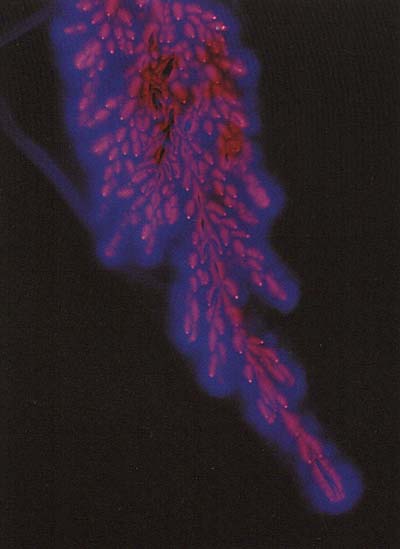
Ветка кустарника.
From the book John Iovine "Kirlian Photography. A Hands-On Guide", TAB Books, 1994.
Добавлено: 06 янв 2007, 23:15
Andrej

Монета
From the book John Iovine "Kirlian Photography. A Hands-On Guide", TAB Books, 1994.
Добавлено: 06 янв 2007, 23:16
Andrej
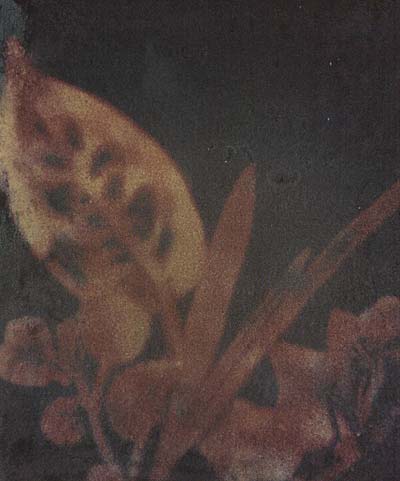
Различные листы растений.
From the book John Iovine "Kirlian Photography. A Hands-On Guide", TAB Books, 1994.
Добавлено: 06 янв 2007, 23:16
Andrej
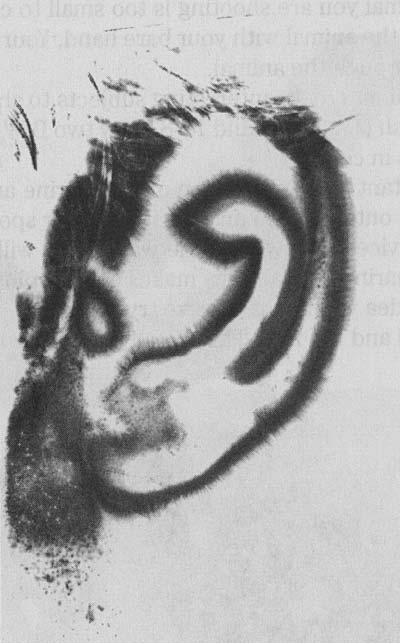
Ухо.
From the book John Iovine "Kirlian Photography. A Hands-On Guide", TAB Books, 1994.
Добавлено: 06 янв 2007, 23:17
Andrej

Пальцы.
From the book John Iovine "Kirlian Photography. A Hands-On Guide", TAB Books, 1994.
Добавлено: 06 янв 2007, 23:18
Andrej
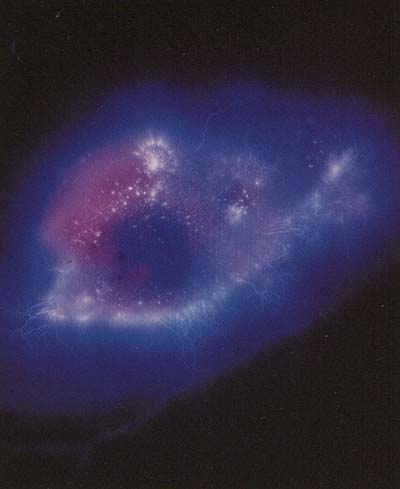
Рыба.
From the book John Iovine "Kirlian Photography. A Hands-On Guide", TAB Books, 1994.
Добавлено: 06 янв 2007, 23:19
Andrej
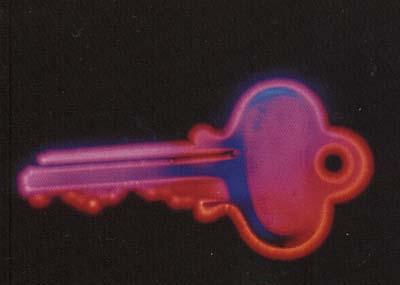
Ключ.
From the book John Iovine "Kirlian Photography. A Hands-On Guide", TAB Books, 1994.
























